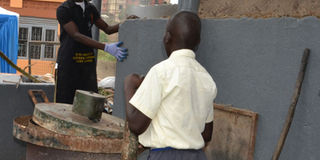School turning solid waste into energy

Students of St Kizito Secondary School in Mukono explain how a carboniser makes the briquettes while below, students show how they sort the garbage they use. Photo by Dan Wandera
Solid waste disposal is one of the biggest challenges for most institutions posing a health risk to people within the institutions and their surroundings.
Some institutions lack enough space for final disposal of the bulk garbage thus end up with huge piles of garbage within their compounds.
At St. Kizito Secondary School in Mukono District, all types of solid waste matter is highly valued because it serves as a source of energy.
The students participate in the waste collection where the garbage dumped at the bins is sorted into categories to ensure that the organic waste is converted into briquettes which are a viable source of energy.
In fact the briquettes produced by students have since replaced firewood which was initially being used at the school kitchen. Some organic waste which does not make good briquettes is converted into biochar organic fertilisers.
“With the economy getting tighter, schools have to devise means to stay afloat. We opted for this cheaper source of energy and it is working for us,” Moses Ssenfuka, an instructor at the briquettes production project of the school told the Daily Monitor recently.
The idea of promoting technology advancement, according to Ssenfuka is what drives the waste energy project because every garbage matters in light of a more efficient and environment-friendly source of energy in form of briquettes.
“Even the food leftovers are now collected, stored and made ready for carbonising,” he says.
Benefitting the community
Ssenfuka says for sustainability purposes, the school has now partnered with the community to ensure that they have additional waste for the briquette project.
“Once the garbage is sorted and dried, the waste is put into a carboniser, a heating machine which burns the waste for 10-15 minutes. The carboniser transforms the bio-waste into carbon which is then crushed into biochar. The biochar goes through an extruder that produces the briquettes before they are exposed to the solar drier that removes moisture,” he says.
Components of the briquettes production machine include; the carboniser, crusher, solar drier and packaging material.
The idea of turning bio-waste into a source of energy is a project implemented by both St Kizito High School, Namugongo and Ndejje University. It was started with an aim of finding a solution to the depleted forest cover where people continue to cut down trees for firewood, according to Ssenfuka.
About 95 per cent of Uganda’s population is dependent on wood and charcoal as a source of energy.
Student involvement
Dr Frederick Kakembo, a director at the school, explains that the project which started as an experimental energy centre in 2016 is now into full scale production of briquettes for use at the school kitchen while students get the opportunity to learn and possibly transfer the same skills to their respective communities.
“We have allowed the community to be part of the school while the learners are supposed to be ambassadors who need to sensitise their respective communities about the environmental friendly source of energy in form of briquettes,” he says.
Kakembo says the fact that students get involved in the process of producing briquettes gives them hope in the world of innovation.
“One of the big challenges has been the sustainability plan which the school is quickly adapting to because we can now get the solid waste from the neighbouring community including hotels, among other institutions.
Our community is yet to acknowledge the fact that solid waste is important and can be turned into a source of fuel in form of briquettes,” he says.
He adds that one of the challenges students encounter is when the community mixes plastics, glass and all types of waste in a single bin thus complicating the process of sorting the waste.
Benefiting the school
The briquettes do not only provide energy at the kitchen, but the ovens that bake the bread sold at the school canteen including the food and nutrition school department.
Ezekiel Kazibwe, the school head teacher, says having an alternative source of energy is one of the great assets the school enjoys since the briquettes provide one of the cheapest energy source obtained from the available local materials in form of waste.
“In one term, we have been utilising more than three tonnes of fire wood but since the advent of briquettes, we have cut the cost by more than half,” Kazibwe explains.
Agnes Nantale, a former student at the school, is one of the pioneer beneficiaries of the project when it was first introduced two years ago. “The knowledge I acquired is helping my parents back at home. We developed a small briquette project which is helping us save money which used to be channelled into buying firewood,” says Nantale, a resident of Nateete, a Kampala suburb.
Why intervention is timely
The more Uganda’s forests have been depleted, the higher the price of charcoal.
Since Kenya slapped a temporary ban on charcoal burning in February, the situation is likely to worsen.
Currently, a sack of charcoal costs between Shs75,000 and Shs80,000 up from Shs60,000 in January. The 2016/2017 household survey conducted by the Uganda Bureau of Statistics revealed that more than 90 per cent of the population use charcoal as their main source of fuel for cooking.



